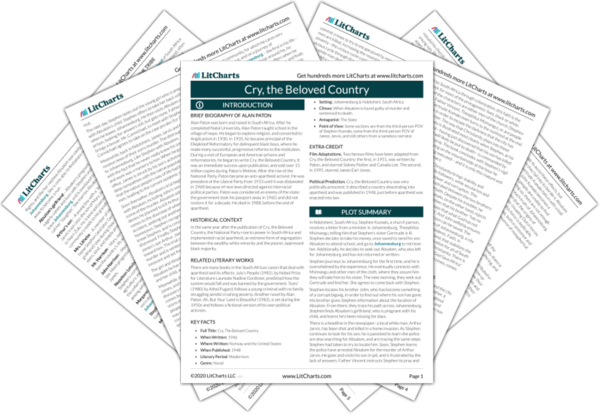Despite the fact that it was the white British and Dutch colonizers who introduced the Christian faith to South Africa through colonization, this faith is the bedrock for most of the protagonists’ lives, black or white. Many of the characters are either men of the church (Stephen Kumalo, Father Vincent, Theophilus Msimangu), or are people of faith. Gertrude Kumalo even turns to the nunhood at the end of the book in order to escape the darkness that the city has visited upon her. The way that Christianity plays into these characters’ lives is illustrated most clearly when Stephen, at his darkest moment—having just discovered that his son has killed a white man and will likely be put to death—is commanded by Father Vincent to pray. The book concludes with Stephen’s vigil – standing and praying on the mountainside at the hour he knows his son is being executed – and it is only this (nature and faith) that gives him peace.
Throughout the novel, Christianity brings stability and tranquility to the lives of its followers, while secularism and atheism are connected to power and corruption. This dichotomy is most clearly illustrated between the two brothers: Stephen is good, and a man of faith. Despite his troubles, he ultimately finds peace. John Kumalo, on the other hand, rejects Christianity. Msimangu tells Stephen that his brother “has no use for the Church any more. He says that what God has not done for South Africa, man must do.” And John selfishly ensures that Absalom will die so that his own son can be saved. The novel ties secularism to the corruption of Johannesburg, a city where the “peace of god escapes” its residents. Faith, in contrast, is portrayed as a force, like the land, that stabilizes the tribe. In fact, the novel implies that the salvation for all of South Africa lies in the eventual uniting force of Christianity. There is a repeated mantra of Nkosi Sikelel’ iAfrika, or “God Save Africa.” And the ground itself, the novel states multiple times, comes directly from The Creator.
Christian Faith ThemeTracker

Christian Faith Quotes in Cry, the Beloved Country
Down in the valleys women scratch the soil that is left, and the maize hardly reaches the height of a man. They are valleys of old men and old women, of mothers and children. The men are away, the young men and the girls are away. The soil cannot keep them any more.
There are times, no doubt, when God seems no more to be about the world.
















